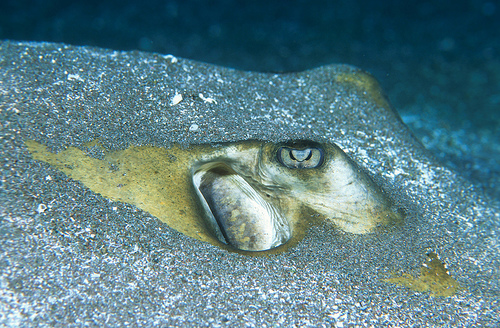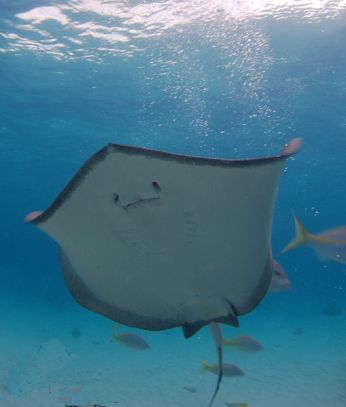Adaptation-
Adju'sting' Rays
 Southern stingrays have extremely
strong senses. They have an excellent sense of smell, hearing,
touch, and they have incredible eyesight. Their ears are tiny
openings on top of their heads with hair-like cells in the inner
ear that detect sound vibrations. Their eyes are also on top of
their heads. They give them a view of the organisms above them
while they are hidden under the sand. Since their eyes are on
top of their heads, they have to rely on their sense of smell,
touch and other special senses to find food.
Southern stingrays have extremely
strong senses. They have an excellent sense of smell, hearing,
touch, and they have incredible eyesight. Their ears are tiny
openings on top of their heads with hair-like cells in the inner
ear that detect sound vibrations. Their eyes are also on top of
their heads. They give them a view of the organisms above them
while they are hidden under the sand. Since their eyes are on
top of their heads, they have to rely on their sense of smell,
touch and other special senses to find food.
Southern stingrays have specialized senses on their ventral surfaces that allow them to sense prey. They have a closed lateral line system that can sense small jets of water pressure. Organisms such as bivalves (mussels and clams) give off small jets of water that strike the ray's surface around this system that allows the stingray to feel the moving current. This sense then leads them to their prey. Southern stingrays also have an electrosense. Electrical activity in muscles and electrical charges in body fluid give all animals a weak electrical field of energy. Stingrays are able to sense these electrical signals and find hidden organisms in the sand beneath them.
Southern stingrays have a modified way of breathing
compared to other water living organisms.
Their spiracles are located behind their eyes, and their gill
slits are on their lower surface. They breath by taking water
into their spiracles and expelling it out of their gill slits. Since
the water is brought in through the spiracles, the mouth is free
to be used to feed, and they are able to breathe while hiding in
the sand.
modified way of breathing
compared to other water living organisms.
Their spiracles are located behind their eyes, and their gill
slits are on their lower surface. They breath by taking water
into their spiracles and expelling it out of their gill slits. Since
the water is brought in through the spiracles, the mouth is free
to be used to feed, and they are able to breathe while hiding in
the sand.
Stingrays do not have a swim bladder nor do they have a large liver with oils to give them buoyancy, so they sink if they do not swim. To compensate for this, stingrays have pectoral fins that form a flattened disc that allow them to swim and glide for long distances. Since stingrays have less buoyancy, it also allows them to hide under the sand and stay stationary for long periods of time. Gliding and lying on the seafloor helps stingrays conserve energy which means they don’t have to eat as often.